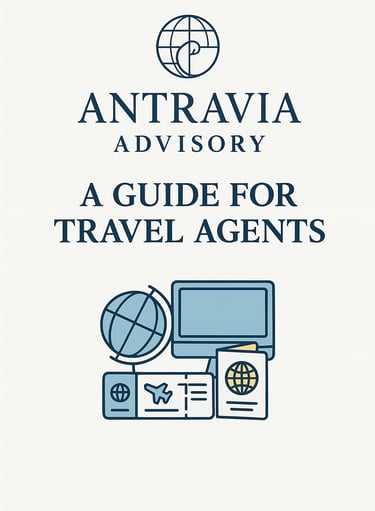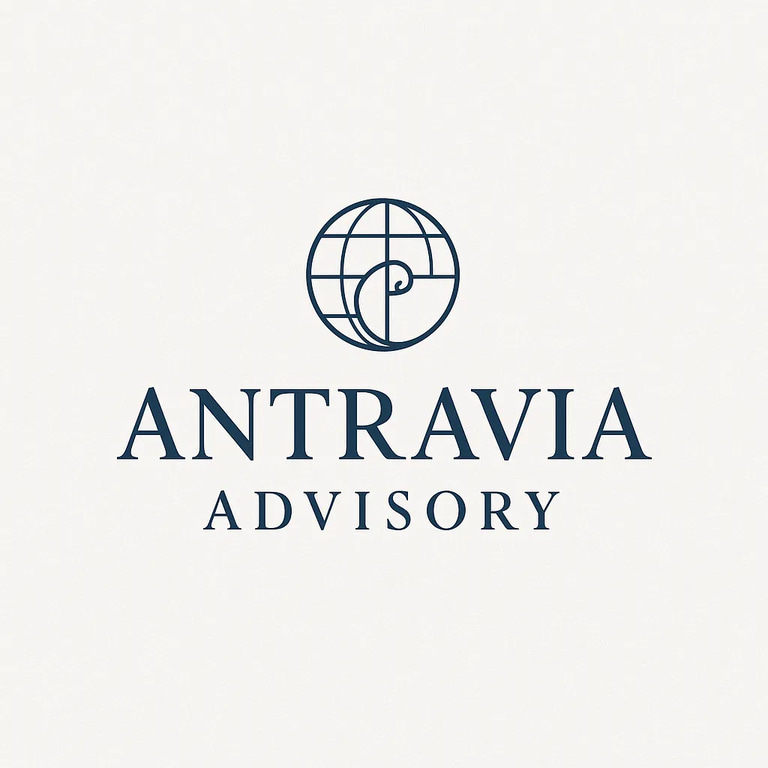
Travel Agent Finance Guide 2025: 6.3 Changing Client Expectations and the Advisor Value Proposition
Part 6.3 of the Antravia Travel Agent Finance Guide - Explore how shifting traveler behavior, transparency, and personalization are reshaping U.S. travel agencies. Learn how fee-based pricing, loyalty data, and measurable value strategies strengthen profit and client retention.
ANTRAVIA TRAVEL AGENT GUIDE
1/24/20258 min read


Part 6 The Future of Travel Agencies
In this part of our Travel Agent Finance Guide, we look ahead at how U.S. travel agencies can build long-term financial resilience in a changing market. Technology, compliance, and consumer behavior are reshaping how agencies operate and earn. The agencies that thrive will be those that use innovation, i.e. using automation to save time, data to guide pricing, and compliance planning to protect margins.
From AI-driven tools and integrated accounting platforms to new reporting rules and client expectations, this section explores what the next five years mean for profitability, efficiency, and advisor value. We will also highlight how these trends tie into Antravia’s broader research, including our U.S. tax and compliance blogs. to help agencies anticipate change rather than react to it.
6.1 Technology and AI in Client Service and Operations
How automation, data, and AI tools are transforming U.S. travel agencies.
Using integrated systems for booking, CRM, and accounting to streamline reporting and forecasting.
Balancing innovation with the personal service that defines the advisor model.
6.2 Regulatory and Tax Shifts Impacting U.S. Agencies
What expanding sales-tax nexus rules mean for travel advisors.
How BOI reporting and transparency requirements affect compliance planning.
Recovering foreign VAT on overseas supplier invoices and conferences.
6.3 Changing Client Expectations and the Advisor Value Proposition
How shifting traveler behavior, transparency, personalization, and fee-based service, changes revenue models.
Financial strategies for agencies adapting to new demographics and demand trends.
Building loyalty and profitability through measurable value creation.


Part 6.3 Changing Client Expectations and the Advisor Value Proposition
The U.S. travel industry is experiencing one of its most fundamental shifts in decades, and not in how people travel, but in what they expect from the professionals who plan their trips. Modern travelers want transparency, personalization, and value that goes beyond a commissionable booking. For travel advisors, this shift is financial as much as cultural: it changes how services are priced, how loyalty is earned, and where margins are made.
1. Transparency and the “Show Your Value” Era
Clients are more informed and price-aware than ever. According to the American Society of Travel Advisors (ASTA, 2025), over 60 percent of U.S. leisure travelers who work with an advisor want to understand how that advisor is compensated. Hidden markups and opaque fees can undermine trust, especially among younger travelers who have grown up booking online.
This has pushed many agencies to introduce itemized pricing and clear service-fee models, such as:
Trip-planning retainers: flat fees for itinerary design and supplier research.
Consultation fees: charged upfront, often credited toward final travel purchases.
Membership or subscription models: annual retainers that guarantee preferred service and access to negotiated rates.
Transparent pricing strengthens trust and allows advisors to charge appropriately for expertise instead of relying solely on supplier commission cycles that can take months to pay.
2. Personalization, Data, and the Financial Impact of Loyalty
Personalization has become both an expectation and a profitability driver. Deloitte’s 2025 Travel Outlook notes that 76 percent of travelers prefer recommendations based on past behavior, and 63 percent are willing to share data for a better experience.
Advisors who track client data in CRM platforms such as Travefy, ClientBase, or Traveljoy can identify:
Which clients generate the highest net margin (after hours spent and commission delays).
When to promote upgrades or ancillary products that increase yield.
How to time outreach to align with clients’ historical booking patterns.
This data-driven approach turns personalization into a financial tool: it increases retention and reduces acquisition costs. Long-term repeat clients have 30–40 percent higher lifetime profitability compared to one-off bookings, according to Skift Research 2025.
3. Sustainability and Purpose-Driven Demand
Younger travelers, and particularly those under 40, increasingly evaluate brands by ethics and sustainability. A Booking.com 2025 survey found that 71 percent of Americans “want to travel more sustainably,” and 43 percent would pay more to do so.
For advisors, this creates new commercial opportunities:
Partnering with suppliers that publish carbon metrics and sustainability certifications.
Offering “low-impact” itineraries or train-based alternatives.
Building marketing campaigns that emphasize social or environmental contributions.
Positioning your agency as a sustainability-minded advisor can attract a premium segment and justify professional-service fees that offset reduced supplier margins.
4. The Fee-Based Future
The reliance on commission-only models is shrinking. More than half of ASTA-member agencies now charge at least one form of professional service fee, which is a trend accelerated by payment delays, supplier defaults, and tighter commission structures.
Financially, this stabilizes revenue and improves forecasting:
Fee income arrives before supplier settlements, improving working capital.
Clients paying fees are more committed to booking, reducing cancellations.
Margins are less exposed to supplier discounting or airline commission cuts.
An agency earning just $100 in planning fees per booking across 1,000 annual transactions adds $100,000 in revenue, without expanding sales volume.
5. Key Trends Shaping Client Expectations in 2025
Clients are demanding experiences that align with their values, budgets, and lifestyles. Drawing from the 2025 Global Travel Trends Report by American Express, 74% of travelers plan 1–3 domestic trips and 59% aim for international ones, but with heightened scrutiny on personalization and sustainability.
Here's a closer look:
Transparency in Pricing and Fees: Post-pandemic, 63% of millennials plan to ramp up travel spending but only if costs are crystal clear, so no surprise markups on add-ons like excursions. Clients expect hybrid models where commissions blend with flat fees, reducing sticker shock. Example: A family safari booking might disclose a $150 planning fee upfront, building trust and cutting refund requests by 15% (per industry benchmarks).
Hyper-Personalization via Data and AI: Gen Z (68% adventure-seekers) and millennials want itineraries tailored to niche passions, like "cool-cations" (off-season escapes to cooler climates) or wellness retreats on private beaches (71% preference). AI tools can analyze past bookings for upsells, but human advisors add the "why", e.g., curating a solo traveler's "meet-a-friend" itinerary with vetted group events.
Value Beyond the Booking: Experiences and Impact: 82% of Gen Z and millennials seek unique, shareable mementos like cultural immersions or sustainable tours, prioritizing "non-aesthetic" depth over Instagram filters. This ties into broader shifts: 55% of Gen Z plan more trips for events like sports tourism or concerts, demanding advisors prove ROI through post-trip feedback loops.
These trends signal a financial imperative: Advisors who adapt see client retention soar by 20–30%, per Deloitte's 2025 Travel Outlook
6. Experience over Price
While value matters, the post-pandemic traveler has rediscovered the importance of security, insight, and service continuity. McKinsey’s 2025 U.S. Travel Sentiment Report shows that nearly 70 percent of travelers prefer booking complex trips through an advisor rather than online. The reason isn’t just price but travelers wanting reassurance.
For advisors, that reassurance is the brand: personalized service, real-time support, and financial transparency. Agencies that communicate this clearly, either through proposals, follow-ups, and financial reports, will hold higher retention and better client quality over time.
7. Connecting Value to Financial Performance
Changing expectations ultimately require measurable proof of value. The most successful agencies now track metrics like:
Revenue per client (total commission + fees – service hours).
Retention rate and lifetime value (CLV) of top clients.
Profit per booking channel (direct vs. host vs. consortium).
These insights tie client behavior directly to financial planning and allow agencies to reinvest intelligently, and in technology, marketing, or training that targets profitable demographics.
8. Overcoming Hurdles: Client Pushback and Implementation Pitfalls
Adapting to these expectations isn't seamless, as many advisors fear fee resistance, with 40% citing "client sticker shock" as a barrier. Counter it by framing fees as "expertise insurance": Educate via webinars or emails, e.g., "Your $250 planning fee saves $500 in avoided OTA fees and stress."
Tech gaps loom too as without CRM integration, personalization falls flat. Solution: Affordable tools like Ezus or TravelPerk for seamless data pulls, aligning with Deloitte's push for AI in 2025 ops. For sustainability demands (key for 77% of millennials), partner with verified eco-suppliers to authenticate claims.
Finally, measure success beyond revenue: Aim for 85% client satisfaction on "value delivered" surveys. Agencies nailing this see 35% YoY growth, proving adaptation pays dividends.
8. Case Study: From Commission Crunch to Fee Freedom
Sarah, owner of WanderWise Travel (names changed to protect privacy), a boutique agency specializing in millennial family adventures. In 2024, OTA dominance squeezed her commissions to under 10% on bookings, leaving margins razor-thin at 4% after marketing costs. Clients grumbled about opaque pricing during peak seasons, leading to a 12% churn rate.
Enter 2025: Sarah adopted a hybrid fee model, 10% commission plus $200 flat planning fees for custom itineraries. Targeting Gen Z parents (58% of whom plan multi-gen trips, per Amex data), she used CRM tools to personalize "cool-cation" packages: Think Iceland hikes with kid-friendly eco-workshops. Result? Average transaction value jumped 25%, with fee-based bookings yielding 18% profit margins, nearly 4x her old commission-only rate.
The change: Transparent value propositions, like post-booking "impact reports" detailing carbon offsets. Churn dropped to 3%, and repeat business hit 65%. As Sarah notes, "Clients pay for the peace of mind and knowing their trip aligns with their values, not just their wallet." This mirrors broader adoption: Over 50% of U.S. advisors now charge fees, stabilizing revenue amid volatile supplier cuts.
7. Linking to Antravia Research
For deeper strategy, see our related Antravia blogs:
“How Travel Agents Can Make Money Beyond Commissions in 2025”
“Wellness and Bleisure Travel 2025 | Profitable Niches for Agents and Hotels”
“Knowing Your Value: What Travel Agents and Hotels Can Learn from an $8 M Pen.”
Each expands on how value perception and pricing transparency drive both financial and emotional loyalty in the modern travel market.


References for Part 6.3 Changing Client Expectations and the Advisor Value Proposition
American Society of Travel Advisors (ASTA) – Independent Advisor Report 2025
https://www.asta.org/Deloitte – 2025 Travel Industry Outlook
https://www.deloitte.com/Skift Research – Travel Trends and Traveler Behavior 2025
https://research.skift.com/Booking.com – Sustainable Travel Report 2025
https://globalnews.booking.com/McKinsey & Company – U.S. Travel Sentiment Survey 2025
https://www.mckinsey.com/industries/travel-logistics2025 Global Travel Trends Report: https://www.americanexpress.com/en-us/travel/discover/get-inspired/global-travel-trends
Millennial Travel Statistics: Trends, Behaviour and More [In-depth]: https://www.atlys.com/blog/millennial-travel-statistics
Gen Z Travel Trends and Statistics in 2025: https://www.peekpro.com/blog/gen-z-travel-trends
Wellness Vacations Are on the Rise as Boutique Offerings Flourish: https://athletechnews.com/wellness-vacations-are-on-the-rise-as-boutique-offerings-flourish/
How Gen Z And Millennials Impact Travel And The Experience Economy: https://www.forbes.com/sites/jefffromm/2025/09/09/how-gen-z-and-millennials-impact-travel-and-the-experience-economy/
2025 Travel Industry Outlook | Deloitte US: https://www.deloitte.com/us/en/Industries/consumer/articles/travel-hospitality-industry-outlook.html
Professional Fees in the Travel Agency Industry White Paper: https://wtaaa.org/wp-content/uploads/2025/07/Professional-Fees-in-the-Travel-Agency-Industry-White-Paper_V5.pdf
More than half of U.S. advisors now charge fees: https://www.travelweekly.com/Travel-News/Travel-Agent-Issues/More-than-half-of-US-advisors-now-charge-fees
Most Travel Advisors Are Charging Fees: https://www.travelagewest.com/Industry-Insight/Business-Features/travel-agent-fees
10 Travel Trends Shaping 2025 | GWI: https://www.gwi.com/blog/travel-trends
Acknowledgements
Antravia would like to thank our consulting clients and industry partners who generously shared their time, insights, and real-world case studies. All client examples have been anonymized and edited for clarity, but they are based on true advisory engagements and reflect real decisions, challenges, and financial outcomes from across the travel industry.


Antravia Advisory
Where Travel Meets Smart Finance
Email:
Contact us:
Antravia LLC
© 2025. All rights reserved. | Disclaimer | Privacy Policy | Terms of Use | Accessibility Statement
Antravia.com - Global site of the Antravia Group.
Antravia.com | Antravia.co.uk | Antravia.ae |
Finance.travel | Tax.travel | Consultancy.travel | Vat.travel | Vat.claims |
USSales.tax | EuroVAT.tax | UKVAT.tax |
contact@antravia.com
Antravia LLC
4539 N 22nd St., Ste. N
Phoenix
Arizona
85016
